History of the study of the moon with automatic vehicles - part 2
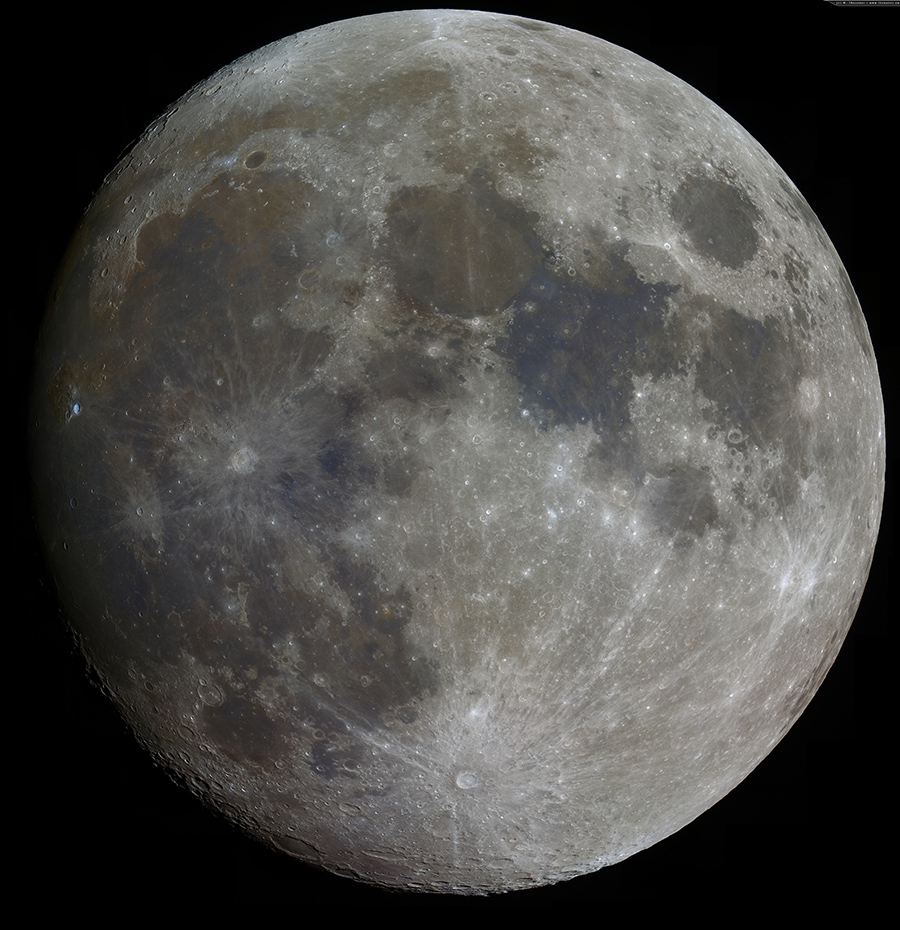
A snapshot of the astrophotographer Michael Teusner processed by the LRGB algorithm.
After the start on August 19, 1976, the last Soviet station Luna-24 began to break from the lunar surface in the exploration of our natural satellite by a whopping 16.5 years. This break was supposed to be 2 years less, but with the first Japanese moon exploration apparatus , Khagoro, the connection was lost shortly after its separation on March 18, 1990 from the mother ’s Hiten . With the help of two JPL employees, a special low-energy orbit was calculated for the main staff, with the help of which he was able to eventually reach the Moon orbit on February 15, 1993 (after 8 of its flyouts, 2 air brakes on the Earth's atmosphere and 3 years of flight).
Thus began the second stage in the explorations of the moon which is still ongoing. It already has 5 participants against the previous 2, and in less than a year 5 private companies participating in the Google Lunar X PRIZE competition should join the participating countries.

“Chiten” had a diameter of 1.4 m with a mass of 197 kg, of which 11 kg was accounted for “Khagoromo” which had a diameter of 40 cm. The main purpose of the mission was to study cosmic dust between Earth and the Moon, as well as an experiment on air braking in the Earth’s atmosphere and the launch of a small satellite into the orbit of the moon (due to a change of plans, it was necessary to do one more aerial braking to correct the orbit). The failure of the small vehicle also gave a positive effect - the “Hiten” was forced to use the interplanetary transport network and fly through the Lagrange points L 4 and L 5 of the Earth-Moon system, during the passage of which no elevated concentration of dust was noticed (as one would expect) . In February 1992, "Khiten" went into orbit of the Moon, and on April 11, 1993 it was broken on its surface.
After a break of 21 years (from the Apollo 17 mission), Clementine, a joint development of NASA and the North American Aerospace Defense Command, became the next vehicle sent to the moon by the United States. In addition to testing military technology, this device transmitted about 1.8 million photographs of the Moon to Earth and provided the first evidence of water on the Moon (in samples of Apollo’s lunar soil and Soviet automatic stations, it was also detected, but until that moment it was thought that it was included in after landing on Earth).

On board was a telescope for charged particles, a UV and visible spectrum camera, an infrared camera, a high-resolution camera (about 7–20 m depending on flight altitude), an exploded radar system that worked in conjunction with the Network ) and an experimental lidar for which a 1064 nm solid-state laser was used. With the help of this lidar, the first volumetric map of the Moon was obtained with an error in measuring the height of only 40 m, but the measured grid was as much as 40 km in latitude and 1-2 km in longitude:
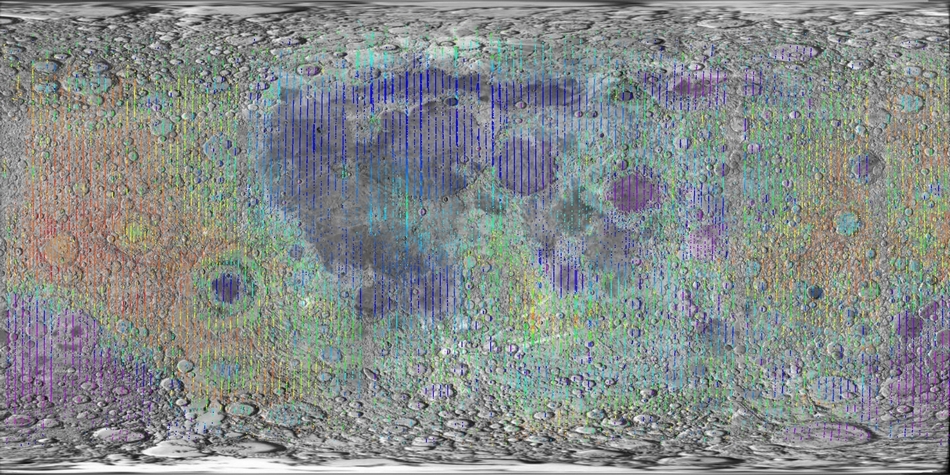
Colored stripes depict analogues of “height above sea level”: from violet (moon seas) to red (moon mountains).

Launched on January 7, 1998, Lunar Prospector was designed to study the magnetic field, the gravitational field of the moon and its internal structure, as well as search for 10 chemical elements: uranium, thorium, potassium, iron, titanium, oxygen, silicon, aluminum, magnesium, calcium. With it, the data of Clementine was also confirmed that there is water at the poles of the moon.
After 570 days of work, the device was sent to a crater at the south pole where ice should have been contained — however, neither ground telescopes, nor even Hubble could detect the fall marks, so new data on lunar water could not be obtained in this way. One of the scientific results of the mission was the Mascon Card:
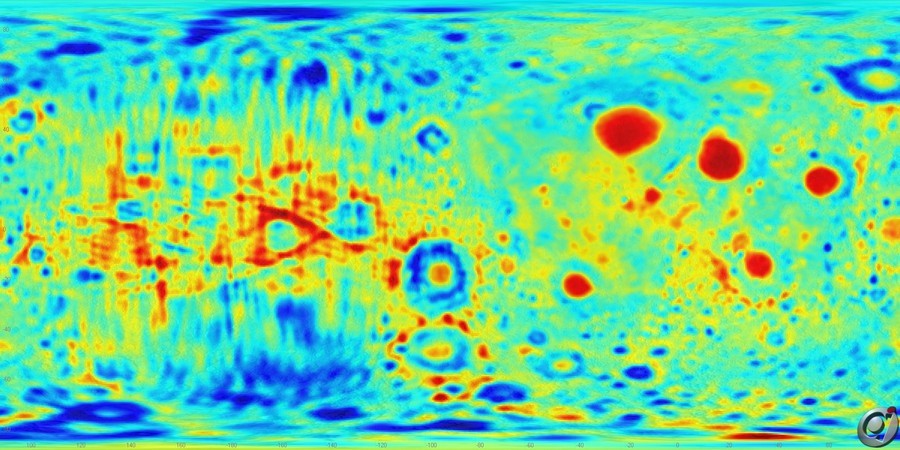
The ESA sent its first automatic station , Smart-1, to explore the moon on September 27, 2003 on an Ariane-5 rocket. The development of instruments for this device involved 12 countries including the United States and Russia represented by the Fakel Design Bureau, which made an engine for it based on the Hall effect together with the French company Snecma.
The automatic station weighing 287 kg was installed: a CCD camera for color imaging, an infrared and X-ray spectrometer, an instrument for monitoring solar activity from X-rays. The device worked until September 3, 2006, when it was broken on the surface of the Moon:
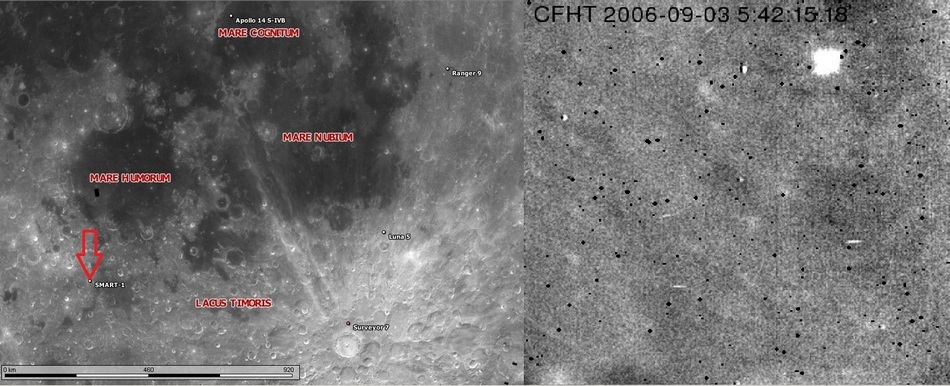
Place a hard landing Smart-1 (bottom left) and a flash from the collision (impact velocity was about 2 km / s). After this event , the Space Research Committee established rules for the protection of planets and their moons from pollution by the remains of spacecraft.
The achievements of this device were the refinement of topographic maps of the Moon (which were later used in Google Moon ), refined maps of mascons on the far side of the moon and received the first visual observation of the internal structure of the Shackleton crater which never gets sunlight (due to its proximity to the southern the pole of the moon). An increased concentration of water was found in this crater.
Already by September 14, 2007, the second Japanese satellite, Kaguya, also known by its abbreviation "SELENE", was launched under the flag of the united JAXA. Like the last Japanese satellite, it was composite:

Small satellites weighed 53 kg each and had their own names: “OKINA” (satellite repeater), and “OUNA” (satellite for interferometry with a super-long base). The main apparatus was installed: a high-resolution television camera, X-ray and gamma spectrometer (designed to determine the chemical composition of the lunar surface), visible and infrared spectrometers, laser altimeter, magnetometer, low-temperature plasma recorder, radio antenna for measuring the parameters of the Earth’s magnetosphere and ionosphere near the moon. Radio beacons were also installed on the devices to measure gravitational fields - this made it possible to measure mascons in areas of the lunar limb, where it was impossible to do with one large apparatus for measurements.
The device worked in the Moon’s orbit until June 3, 2009, but using its data, the lava tubes were recently discovered on the Moon (which can be a natural refuge for the first lunar bases), and the “sunset of the Earth” was captured with its cameras:
Just a month after the launch of the Japanese apparatus (October 24), China launched its first lunar satellite, and it was Chang'e-1 sent on the rocket "Great March 3A". In total, the device weighed 2350 kg, of which only 130 kg was allocated to the payload. Among its instruments was a stereo camera with a resolution of 120 m, a laser altimeter with a measurement accuracy of 1 m in height and a measurement step of 300 m, charged particle detectors, a microwave radiometer and a solar wind detector.
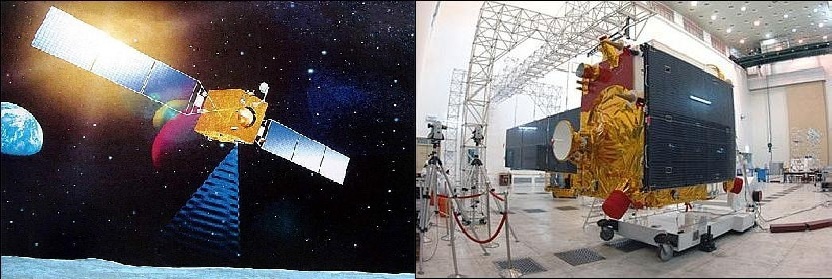
His tasks included three-dimensional mapping of the surface of the moon, the search for 14 chemical elements: potassium, thorium, uranium, oxygen, silicon, magnesium, aluminum, calcium, tellurium, titanium, sodium, magnesium, chromium and lanthanum. Refinement of data on the presence of helium-3 on the Moon and the study of the medium between the Earth and the Moon (in total, the device transmitted 175 GB of data to Earth). March 1, 2009, the unit was also broken on the lunar surface.

Topographic map of the moon compiled according to the apparatus
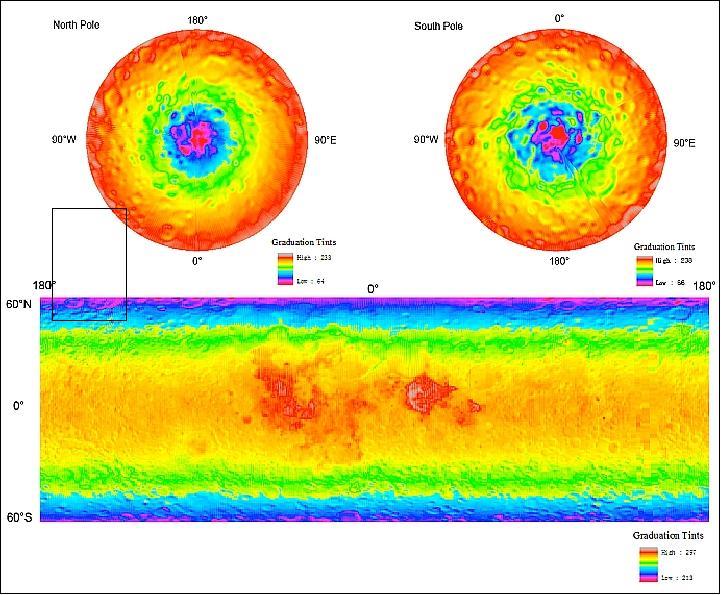
Map of the daytime radiation of the moon at a frequency of 37 GHz

Map of the night radiation of the moon at a frequency of 37 GHz
The map shows that the total level of radiation at night falls (since sunlight is the main source of energy for this process), shifting it to the area of longer waves leads to the fact that in the microwave range even the radiation power increases.
The last country to reach the moon at the moment, was India. Her space probe , the Chandrayan-1, launched by the PSLV-XL launch vehicle on October 22, 2008, had a total weight of 1,380 kg, of which 675 kg of dry weight remained on arrival to the Moon. In addition to scientific instruments, it included a spectrometer, a dosimeter, a camera, and a laser for measuring the relief. It included a shock probe, which on November 14 made a hard landing on the lunar surface. The probe also received updated data on the water content in the lunar rocks:

Unfortunately, the device worked only 312 days from the planned 2 years, but the Indian Space Research Organization ( ISRO ) announced the implementation of the planned program by 95%. During the work of Chandrayan-1, 70 thousand photographs of the lunar surface were transmitted, more than 40 lunar craters were discovered near the north pole (in which sunlight also never gets and in which it is estimated there should be 600 million tons of water ice). According to the latest received from the apparatus according to its trajectory, it should break on the surface of the Moon before the end of this year.

Like SELENE, Chandrayan-1 did not have the opportunity to capture Apollo’s landing sites in photographs with sufficient resolution. But in January 2009, ISRO published the results of testing the landing sites of Apollo 15 and Apollo 17, during which data were obtained that the soil in these areas is more loose (which is explained by the work of the Lunar module landing engine and the effect of the Lunar vehicle ).
The next NASA mission was the “Preliminary Program for the Study of the Moon by Machine Guns ” ( LPRP ), which was launched on July 19, 2009. Initially, on this mission only the Lunar Orbital Probe ( LRO ) was to be delivered to the Moon, which continues to work until now, but changing the launch vehicle from Delta-2 to Atlas-5 allowed increasing the scientific load and adding to The mission of the second device is the “Spacecraft for Observing and Sensing Moon Craters” ( LCROSS ).

LCROSS device
On October 9 at 11:31 UTC of the same year, an accelerating unit with a residual mass of 2,305 kg at a speed of about 2.5 km / s crashed into the surface of Cabeo’s lunar crater near the south pole, after which only four minutes later ... LCROSS followed . The reason for such a strange order of NASA with its devices was simple: with the help of an upper stage, a cloud of gas and dust was picked up and analyzed by LCROSS before its collision with the surface. LRO, telescopes on the Earth, Hubble and the European satellite Odin watched the whole process from above (this time everything went great and all the telescopes recorded flashes, and amateur astronomers who had telescopes with an aperture of 25 cm and more).
LCROSS was able to detect the release of about 150 kg of water during the impact, which corresponded to the water content in the circumpolar regions of the lunar soil of the order of 5.6 ± 2.9%. Carbon monoxide, hydrogen, calcium, mercury, and magnesium were also found in elevated gas and dust; traces of silver, sodium, ammonia and hydroxyl groups were found.

LRO device and its composition: CRaTER - a telescope for cosmic rays, DLRE - a device for measuring thermal radiation of the surface, Mini-RF - a small radar for communications technology tests and a search for water, LEND - a neutron detector for mapping water reserves, NAC - a camera high resolution, LAMP - a device for the study of eternally shaded craters on the infrared radiation of stars and hydrogen atoms inside the solar system, LOLA - a laser for making 3-dimensional topographic maps, WAC - a camera of low resolution.
According to the LOLA instrument, a detailed map of the moon was made:

Video comparing the LRO data card existing at that time:
Already by 2011, during the operation of the device, 192 terabytes of data were received - this exceeded the total amount of data obtained from other planetary missions. Most of this data was made up of images of the surface, with the help of which even the meteoric situation of the moon was studied by comparing photographs taken at different times and searching for new craters on them. With the help of LRO, the most accurate images of Apollo landing gear at the moment were also obtained:

The landing site of Apollo 11: in the first flights of the Apollo, the lunar vehicle was not yet ready, so the astronauts walked on the moon and many "inherited."
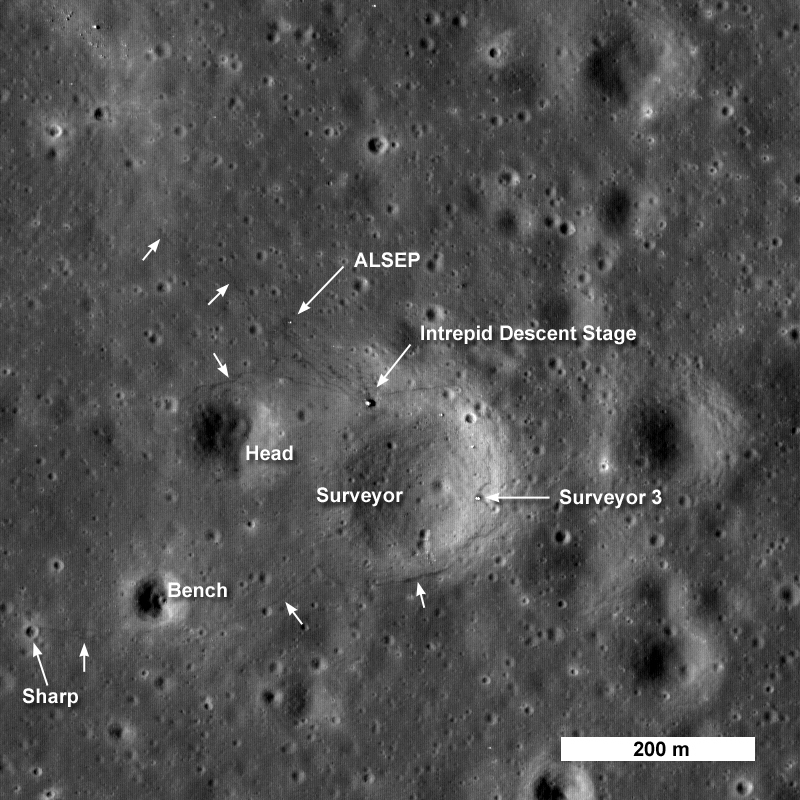
Apollo 12 landing site. Traces of people are visible poorly, in the form of uneven lines.

Landing places of Apollo 14-17.
In January 2013, with the help of LRO, an experiment was conducted with one-way data transmission via a laser beam to the LOLA device. The transmitted data was the image of Mona Lisa . Using LRO, other properties of the Moon are also being studied: in this video, you can see the phases of the moon and its libration for 2014 (the speed of the video corresponds to 24 seconds per real month):
Chang'e-2 became the second Chinese satellite to go to the Moon on October 1, 2010: in general, it was similar to the previous one, but it had a new laser range finder and a high resolution camera (up to 1.3 m). The main task of this device was the search for possible landing sites for the first Chinese lunar rover (for which the resolution of the range finder was increased to 10 m).

Chang'e-2 flight pattern: after completing its main program, it was sent to the L2 point of Lagrange of the Earth-Sun system and then to study the Tautatis asteroid, which it reached on April 15, 2012.
The next satellites that went into orbit of the Moon were 2 of the 5 instruments of the THEMIS mission: the mass of each of them was 126 kg, of which 49 kg were of fuel. The scientific equipment of the apparatus included: a fluxgate magnetometer and a magnetometer with a search coil, an electrostatic analyzer, a semiconductor telescope for measuring high-energy particles.

THEMIS B and THEMIS C of these 5 satellites, shot with the third stage of the Delta-2 booster rocket and half of the fairing, hit the Moon's orbit.
As part of the main program, they studied the Earth’s magnetic field, magnetic storms and auroras. For this reason, although they were launched on February 17, 2007 (before the second Chinese satellite), these two satellites only got into the lunar orbit only on July 2 and 17, 2010, as part of the extended ARTEMIS mission. This mission of satellites is to study the interaction of the Moon and the Sun and continues to this day.

The ARTEMIS P1 and ARTEMIS P2 satellites (renamed THEMIS B and THEMIS C, respectively) in the Moon’s orbit as presented by the artist
The next NASA mission was GRAIL - a program to study the gravitational field of the moon and its internal structure. Two identical satellites for this program were launched on September 10, 2011 by the Delta-2 launch vehicle and had their own names: Ebb (GRAIL A) and Flow (GRAIL B), which meant Low Tide and Tide. They received such names after their launch, when NASA announced a competition for their names among schoolchildren. About 900 schools offered the names, and the authors of the names that won the competition were the children from the 4th grade of the school Emily Dickinson from Bozmen , Montana:

Among the instruments, the devices had Ka-band radio beacons for communication among themselves and radio beacons for communication with the Earth. Also, both cameras were installed on 4 cameras (MoonKAM) for shooting is not of the highest quality as it was not part of the main scientific program - these cameras were designed to control schoolchildren (not directly of course).

The operation scheme of the vehicles looked like this: both satellites flew in one orbit at an altitude of about 50 km above the Moon, making constant communication between themselves and two intervals of 8 hours a day - with the Earth. By changing the orbits, the mascons were measured, and the internal structure of the moon was already studied. To compensate for the influence of low-orbit mascons, constant fuel consumption was required, so that after it ended, the vehicles fell and crashed on the surface on December 17, 2012.
On September 7, 2013, a new NASA research mission was launched, called LADEE - “Researcher of the lunar atmosphere and dust environment”. The very rarefied lunar atmosphere (having a pressure of 3 * 10 -15 from the Earth's) was recorded by the scattering of sunlight at the level of the horizon by astronauts, but its real research began only with this device.

The scientific instruments of this mission included: a mass spectrometer, a UV and visible light spectrometer, a dust sensor and a laser communication demonstrator (LLCD). After monthly checks in the Moon’s orbit, the main scientific phase of the mission began, which took place in an orbit similar to the previous spacecraft (about 50 km) for 128 days. It was determined that the main components of the lunar atmosphere are helium and neon (supplied by the solar wind) and argon.

3D model LLCD
After the main phase, the device was raised to a higher orbit where the experiment was carried out with high-speed communication from the Moon’s orbit by means of a laser beam: the achieved speed was 622 Mbit / s from the device and 20 Mbit / s to it. The LADEE mission ended on April 17, 2014 with another encounter of the apparatus with the Moon. The following ground tests of the laser communication system from NASA are scheduled for this year, and tests in orbit will be conducted in 2019 already on a commercial satellite.
Already on December 1, 2013, the third Chinese Chang'e-3 mission was launched, which included a landing platform and the first Chinese lunar rover, Yuytu .December 14 was marked by the first soft landing on the lunar surface for 37 years (since the time of the Soviet station Luna-24) and the first lunar rover, delivered to the lunar surface for the whole 40.5 years (after Lunokhod-2 ).
The landing platform had a UV camera and 3 cameras of the visible spectrum, and a UV telescope was installed on it, which became the first telescope delivered to the Moon. It was intended to study binary and variable stars, as well as active nuclei of galaxies and other objects with brightness above 13 stellar magnitude .

A picture of Yuytu on the surface of the Moon, taken with the help of the camera Chang'e-3
The Yuuta lunar rover (jade hare) weighed 140 kg and had on board two pairs of panoramic and navigation cameras, an X-ray and infrared spectrometer, and a radar to study the internal structure of the Moon to a depth of several hundred meters. With the help of it, it was found that the layers of soil in the landing zone consist of as many as 9 layers, which indicates the turbulent geological processes that took place at this place in the early stages of the development of the moon.
The landing platform was calculated to work 1 year on the surface of the moon, and the lunar rover - for 3 months, but unfortunately the mechanical breakdown was already at the end of the second lunar day (which is closeto the earth month) did not allow one of the solar cells to fold properly (on a lunar night, the temperature drops to -180 ° C and the moon rover has to spend energy from its batteries to heat). This led to the fact that on the third “lunar morning” after his landing, Yuyu lost the opportunity to move, but the connection with him was maintained until August 3, 2016. The landing platform with UV cameras and a telescope operated at least until January 14, 2015, and at the end of the same year, the Chinese Academy of Sciences published information on the discovery of basaltic rocks containing ilmenite based on the landing platform data .

Ouitu was able to drive more than 100 m on the surface of the Moon. Chang'e-51
station launched on October 23, 2014It has become the 4th Chinese mission sent to the Moon and the last of the currently launched missions to study it. It consisted of two modules designed for tests of the future Chang'e-5 mission for the delivery of lunar soil: the return module flew around the moon and landed in China on October 31 and the service module conducting virtual docking tests on the lunar orbit and taking pictures of the landing site of Chan-5. Also, with the third stage of the rocket The Great March-3C of this mission, the first commercial cargo was delivered to the Moon - it was 4MOHS System's LuxSpace subunits with a radio beacon and dosimeter. The company sent this small 14-pound satellite in honor of its founder - Manfred Fuchs. For radio amateurs, who caught the signal of his radio beacon and transferred it to the company LuxSpace, awards were provided.

Returnable Chang'e-5T1 after landing
Current state
At the moment, LRO , a pair of ARTEMIS satellites and the Chang'e-5T1 service module remain in working condition in the Moon’s orbit . During 58 years of exploration of the Moon , 110 missions were sent to it by 6 different countries from which 52 failed. The order of the beginning of the research is as follows:
| the USSR | January 4, 1959 |
| USA | March 4, 1959 |
| Japan | February 15, 1993 |
| European Union | November 15, 2005 |
| China | November 5, 2007 |
| India | November 8, 2008 |
| the USSR | February 3, 1966 |
| USA | June 2, 1966 |
| China | December 14, 2013 |
Future missions
The Chinese Chang'e-4 mission to deliver the Uytu analogue to the far side of the Moon, originally scheduled for 2015 — is now postponed to the end of 2018, and the Chang'e-5 mission originally scheduled for November of this year — was postponed to 2019. Thus, now 5 teams participating in Google Lunar X PRIZE are competing for the role of the next one who sent the mission to the Moon and ... India, its second unit for researching the Moon Chandrayaan-2, should be launched in the first quarter of 2018 blood from the nose "must have time to go to the moon before March 31, 2018 to fulfill the conditions of the competition) Initially, Chandrayaan-2 was planned to be launched in 2013 together with Russia, but after a couple of accidentsIndian launch vehicle GSLV and the Phobos-Grunt accident , as well as postponement of the launch of the Russian landing platform - India decided to refuse to cooperate and do the entire mission itself.

Among the teams participating in X PRIZE currently remain : Moon Express (USA), Synergy Moon (international line-up), Hakuto (Japan), Team SpaceIL (Israel) and Team Indus (India). Unfortunately, the only Russian team “Selenokhod” was retired at the end of 2013. The launch of the first Japanese lunar rover as part of the SELENE-2 mission is also scheduled for 2018 . From 2019 to 2021, another JAXA - SLIM mission was moved forward , providing for landing with an accuracy of 100 m.

At the end of 2018, it is plannedSpaceX mission to send tourists to fly around the moon. Since Falcon Heavy should be used for the flight (test launch of which is scheduled for the end of this year) and the piloted Dragon V2 capsule (the first test flight of which to the ISS is scheduled for April 2018) this flight may be postponed, like everyone else on this list. At the moment, SpaceX is finishing the repair of the LC-40 launch pad damaged by the Amos-6 tests - this will allow you to transfer the Falcon 9 launches to the LC-39A launch pad in early December and release the LC-40 for the latest preparations for the launch of the Falcon Heavy. The static tests of the two already flying stages and the new central unit for the Falcon Heavy are scheduled for December 20, and the start of the Falcon Heavy should take place on December 29 .
The first mission of the SLS launch vehicle and the Orion spacecraft is to fly around the moon and was scheduled for September 30, 2018, but was postponed to 2019.

Together with the test of the launch vehicle and the new ship, 11 cubic centimeters of 6U format: Lunar Flashlight (which will search and measure lunar water deposits and will be driven by a solar sail) should go to the Moon as a secondary load in this mission. Near-Earth Asteroid Scout (his goal is to search for asteroids of the 1-100 m range and he will also be set in motion by a solar sail), BioSentinel (which will have to study the influence of radiation in the near-earth space on DNA for one and a half years), two cubes each ordered by Lockheed Martin and Morehead State University. The 6 remaining places will be played in the "Cube Quest Challenge" organized by NASA among American teams. From top to bottom: Lunar Flashlight, Near-Earth Asteroid Scout and BioSentinel. First mission
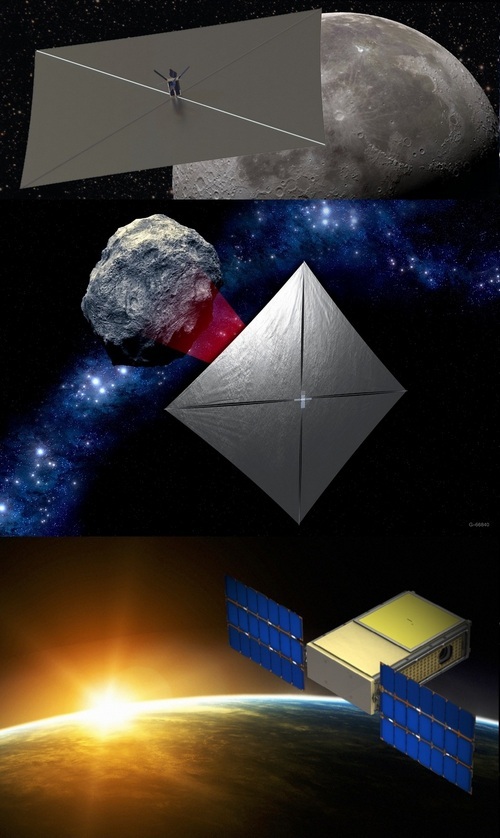
The Russian lunar program ( Luna-25 ) was repeatedly postponed and since 2012 it has already moved to the end of 2019. But despite the fact that the 5th mission with the lunar rover "flew out" of FKP-2025, as well as the mention of the manned lunar program - the 4th mission to the Moon are still in the plans for launching until 2025:
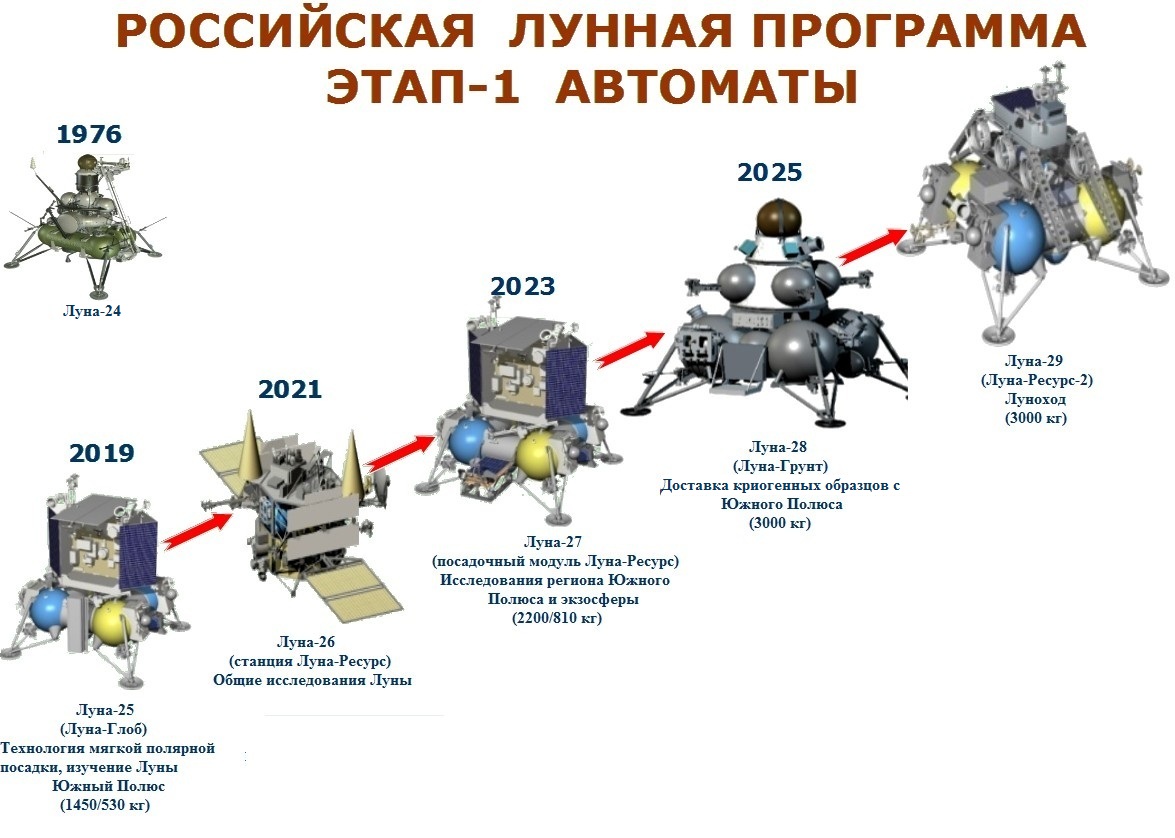
All Articles